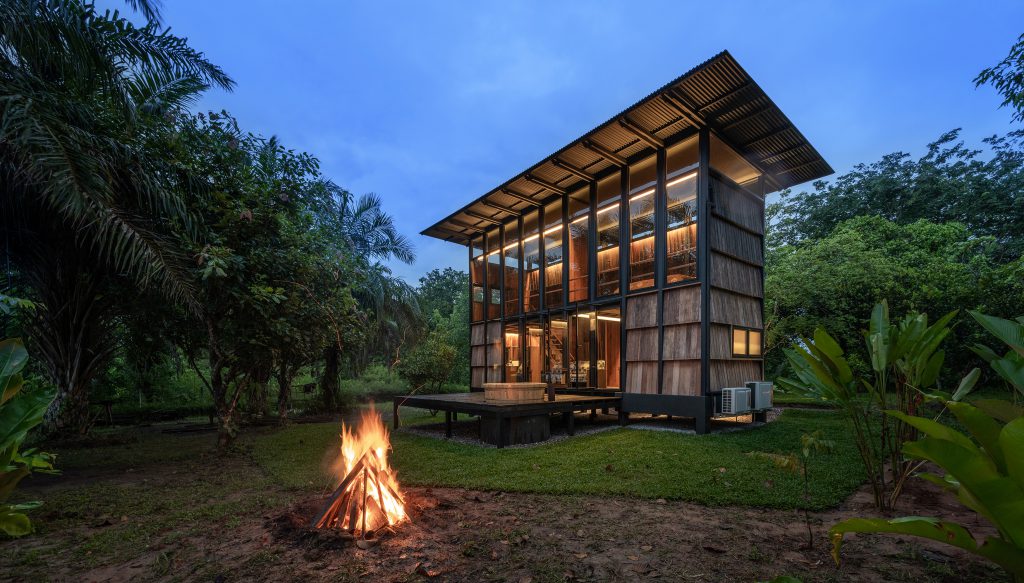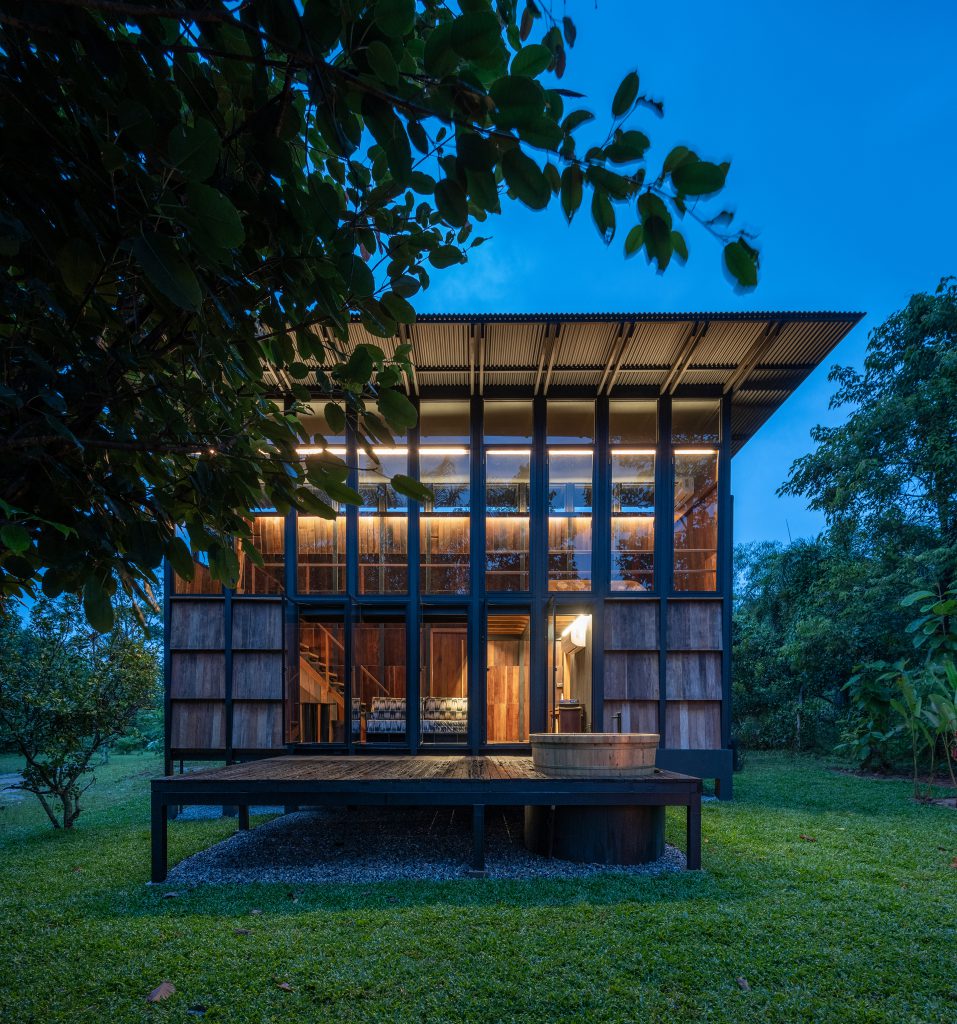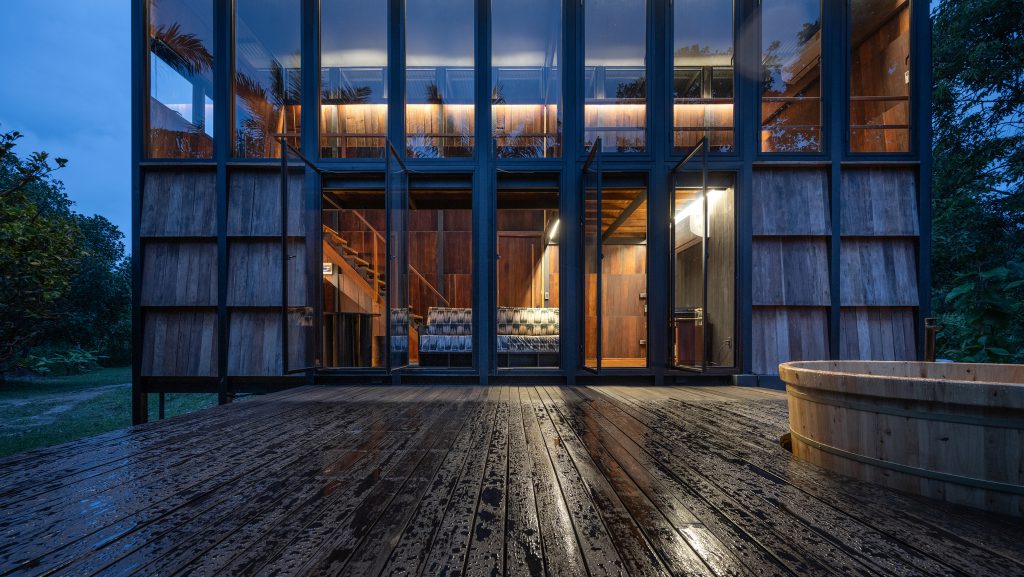In the design of wood and mountain cabin in Chiang Mai, Sher Maker has applied the centuries-old Japanese technique of treating wood onto the reclaimed wood cladding to create a new expression for the façade.
Text: Natre Wannathepsakul
Photo Courtesy of Sher Maker and Rungkit Charoenwat except as noted
Download the online journal Issue 04 Towards Circular Living Click here

ภาพในจินตนาการของกระท่อมกลางป่า ความสันโดษของอาคารที่อยู่บนยอดเขา หรือในป่าลึกที่รายล้อมไปด้วยต้นไม้และเสียงสิงสาราสัตว์ อาจจะไม่ใช่สิ่งที่เกิดขึ้นที่นี่ Wood and Mountain Cabin คือ สถานที่ๆ ตั้งใจจะเป็นดินแดนอันห่างไกลผู้คนและความวุ่นวาย กระท่อมส่วนตัววางตัวโดดเดี่ยวอยู่ในพื้นที่กว้างใหญ่ ที่นี่ไม่มีการให้บริการใดๆ และผู้มาพักจะต้องดูแลแลจัดการตัวเอง เหมาะสำหรับประสบการณ์ปลีกวิเวกที่ตั้งใจจะมอบให้กับกลุ่มเป้าหมายหลักที่เป็นคนเมืองขนานแท้ โดยอาคารตั้งอยู่ห่างจากตัวเมืองเชียงใหม่เพียง 20 กิโลเมตร ที่นี่ไม่ใช่ Walden แต่ละม้ายไปทาง Farnsworth House ใน Plano ที่ต้อนรับผู้มาเยือนเพียงช่วงเวลาสั้นๆ (เหมือนอย่างที่บ้านกระจกหลังนั้นควรจะเป็น)
กระท่อมหลังนี้ประกอบไปด้วยห้องนั่งเล่น พื้นที่ประกอบอาหาร ห้องน้ำ และห้องนอน เพื่ออำนวยความสะดวกสบายแบบสมัยใหม่ ทุกพื้นที่ถูกออกแบบและจัดวางให้อยู่ภายในผังพื้นขนาดย่อมสองชั้น หน้าต่างสูงจากพื้นยันเพดานเปิดพื้นที่ภายในออกสู่ชานนอกบ้าน ถัดออกไปเป็นลานหินกรวดไว้สำหรับปิ้งบาร์บีคิวและก่อไฟ การเข้าถึงกระท่อมหลังนี้ไม่ต้องเดินบุกป่าฝ่าดงแต่อย่างใด เพราะคุณสามารถขับรถไปถึงตัวอาคารได้เลย (ดังที่ผู้มาเยือนมาบางคนทำด้วยความไม่รู้ ทำให้ไม่ได้สัมผัสประสบการณ์การเข้าถึงพื้นที่ที่สถาปนิกออกแบบเอาไว้อย่างตั้งใจ) แต่หากเดินไปตามทางที่ว่า การเข้าถึงตัวอาคารที่ถูกออกแบบไว้จะนำพาผู้มาเยือนไปเผชิญหน้ากับผิวผนังอาคารรูปลักษณ์โดดเด่นด้วยไม้เผาไฟสีเข้ม ที่ทำหน้าที่เป็นทั้งองค์ประกอบที่สร้างความประทับใจแรก เป็นภาพจำ และหัวใจของโครงการ เช่นเดียวกับทำหน้าที่สะท้อนแนวทางสถาปัตยกรรมของ Sher Maker สำนักงานออกแบบสถาปัตยกรรมรุ่นใหม่ไฟแรงนำโดยพัชรดา อินแปลง และธงชัย จันทร์สมัคร
แปลงที่ดินของอาคารนี้มีรูปทรงสี่เหลี่ยมผืนผ้า โดยฝั่งที่สั้นกว่านั้นหันหน้าไปทางถนนหลักด้านตะวันออกและไปสิ้นสุดที่ลำธารเล็กๆ ในด้านทิศตะวันตกที่อยู่ติดกับถนนลูกรังที่มักมีคนในพื้นที่เดินเท้าหรือขับมอเตอร์ไซค์ผ่านไปมา เมื่อเข้ามาจากถนนสู่ผืนที่ดิน ตัวอาคารจะปรากฏให้เห็นแต่ไกลพร้อมกลุ่มต้นไม้สองกลุ่มปรากฏขนาบข้าง ทำหน้าที่เหมือนกรอบรูปให้กับตัวอาคารและบดบังบางส่วนไว้ในเวลาเดียวกัน ตัวกระท่อมตั้งอยู่พื้นที่ที่สูงกว่าพื้นที่โดยรอบ โดยตัวโครงสร้างอาคารนั้นถูกยกสูงขึ้นจากพื้นดินดังเช่นอาคารไม้ท้องถิ่นที่พบเห็นได้ทั่วไปในภูมิภาคนี้ ทางเดินยกระดับนำผู้มาเยือนเข้าสู่ประตูทางเข้าหลักของที่พัก นำพาเราให้ประจันหน้ากับแผงผนังด้านหน้าของกระท่อม เมื่อเดินเข้าไปสู่ภายใน อาคารทำหน้าที่เป็นเหมือนพื้นหลัง เป็นฉากให้กับโลกภายนอก ก่อนที่ความสนใจของเราจะหันออกไปหาพื้นที่ด้านนอกและวิวธรรมชาติที่ปรากฏอยู่เบื้องหน้า

สถาปนิกต้องการที่จะสร้างผิวอาคารที่โดดเด่นและสร้างความประทับใจเมื่อแรกเห็น วัสดุและเทคนิคการก่อสร้างหลายรูปแบบถูกนำมาพูดคุยถกเถียงกับลูกค้า ที่หนึ่งในนั้นเป็นกราฟฟิคดีไซเนอร์ที่ผันตัวมาเป็นนักทำเฟอร์นิเจอร์อย่าง วชิระ ทองหล่อ พวกเขายังคิดไปถึงการลองใช้วิธีการย้อมครามกับไม้ อันเป็นเทคนิคที่วชิระได้ทดลองกับงานของเขามาแล้วระยะหนึ่ง ก่อนที่จะตกลงใช้วิธี shou sugi ban (หรือ yakisugi) วิธีการเตรียมไม้ซีดาร์สำหรับปิดพื้นผิวที่เป็นเทคนิคที่คงอยู่มาหลายร้อยปีจากญี่ปุ่นที่ตอนนี้กำลังกลับมาเป็นที่นิยม โดยเทคนิคดังกล่าวได้รวมเอาวิธีการเผาไม้ อบเย็น ทำความสะอาดและเคลือบผิวไม้ด้วยน้ำมันธรรมชาติ ผลลัพธ์ที่ได้คือไม้โทนดำเข้มที่มีคุณสมบัติทนทานต่อไฟ รา น้ำและแมลง พัชรดาอธิบายว่าเทคนิคดังกล่าวถูกนำมาประยุกต์ใช้กับงานนี้เพื่อสร้างสุนทรียะมากกว่าการเพิ่มการป้องกันการเสื่อมของคุณสมบัติทางกายภาพของวัสดุ ไม้เนื้อแข็งเก่าที่ผ่านการใช้งานมาแล้วถูกนำมาจากหลากหลายร้านในอำเภอบ้านธิ จังหวัดลำพูน ซึ่งเป็นแหล่งซื้อขายไม้เก่าบริเวณรอยต่อระหว่างลำพูนกับเชียงใหม่ สภาพเดิมของไม้เหล่านี้มีสีและพื้นผิวที่แตกต่างกันไป ด้วยการใช้เทคนิค shou sugi ban จึงช่วยสร้างความเป็นอันหนึ่งอันเดียวให้กับไม้จากหลากหลายที่รวมไปถึงการกำหนดการไล่สีอีกด้วย
สำนักงานของ Sher Maker ตั้งอยู่ในจังหวัดเชียงใหม่ ซึ่งเป็นความตั้งใจที่จะฉีกตัวเองออกมาจากบริบทของเมืองหลวงที่บริษัทสถาปนิกมักจะกระจุกตัวกันอยู่ พวกเขาทำงานกับช่างฝีมือท้องถิ่น แต่อย่างไรก็ดี “เราไม่ได้เป็นสายหัตถกรรมฮาร์ดคอร์อะไรขนาดนั้น” สำหรับ Sher Maker พวกเขาให้ความสนใจกับการพัฒนาวิธีการออกแบบที่จะช่วยให้เกิด “การแสดงออกถึงความเป็นมนุษย์ในระดับสูง” โดยพัชรดาอ้างอิงไปถึงงานของสถาปนิกอย่าง Carlo Scarpa “เราไม่ได้ชอบภาษางานของเขา แต่เราชอบวิธีการออกแบบวิธีการก่อสร้างของเขา เช่น ในอาคารสักหลังหนึ่ง ใน 100% จะมี 15% ที่จะเป็นการแสดงถึง human expression ในรายละเอียดของอาคาร เช่น การย่อมุมที่ต้องใช้ทักษะช่างขั้นสูงในการสร้าง ในขณะที่ส่วนอื่นๆ ของอาคารจะเป็นเทคนิคการก่อสร้างที่ช่างปกติทำได้ ส่วน 15% นี้จะต้องการทักษะชั้นสูงกว่ามาก ต้องใช้ช่างที่มีความตั้งใจสูงมาก”


สำหรับกระท่อมหลังนี้ 85% คืองานโครงสร้างเหล็กและเทคนิคการก่อสร้างที่ช่างท้องถิ่นสามารถรับมือได้อย่างไม่ยากเย็นอะไร ในขณะที่อีก15% หรือส่วนที่พัชรดาเรียกว่า “hardcore expression” ของงานปิดพื้นผิวด้วยแผ่นไม้นั้นเป็นส่วนที่ทำขึ้นที่สตูดิโอของสถาปนิกเอง สตูดิโอที่ว่าเป็นโครงสร้างที่มีหลังคาจั่วขนาดใหญ่ เหมือนโรงงานช่างมากกว่าสำนักงานออกแบบ โดยผู้อยู่เบื้องหลังคือทีมสถาปนิกและนักศึกษาที่ควบคุมการเผาไม้ด้วยมือ เพื่อให้ได้มาซึ่งระดับความไหม้ที่ต่างกันของไม้เพื่อให้เกิดการไล่สีบนเปลือกหุ้มอาคาร โครงสร้างเหล็กผอมบางและหลังคาแบนเมื่อถูกนำมารวมเข้ากับไม้ที่มีพื้นผิวลวดลายชัดเจนทำให้อาคารดูทันสมัยและมีความเป็นท้องถิ่นในเวลาเดียวกัน เมื่อมองใกล้ๆ ผลลัพธ์ที่ได้คือพื้นผิวไหม้ที่ไม่เท่ากัน และความหยาบเล็กน้อยที่สะท้อนร่องรอยของมือมนุษย์ และความเป็นธรรมชาติที่รายล้อมอยู่รอบตัวอาคาร
15% ของ Sher Maker นั้นไม่ได้ผูกติดอยู่กับวิธีการหรือรูปแบบใดเป็นพิเศษ แต่เป็นการค้นหารูปแบบการก่อสร้างหรือแสดงออกถึงวัสดุ และกระบวนการทำงานรูปแบบใหม่ ๆ อย่างต่อเนื่อง ความพยายามนี้ถูกขับเคลื่อนด้วยความหลงใหลของสถาปนิกต่อการสร้างสรรค์สิ่งต่างๆ ด้วยมือของมนุษย์ แม้ไม่มี 15% ที่ว่า อาคารหลังหนึ่งก็ยังคงดูดี ใช้งานได้ปกติ แต่ด้วย 15% นี้เองที่สถาปัตยกรรมจะมีชีวิตอยู่อย่างมีพลังและความหมาย
To think of a cabin in the woods might conjure up an image of utter seclusion atop the mountains, or in a forest studded with trees and the cries of wild animals…that’s not quite the case here at Wood and Mountain Cabin. While it does intend to be a place where one can experience being in the ‘middle of nowhere’ in a single private cabin on a large site with no services and guests are left to their own devices, its appeal is nevertheless geared towards those incorrigible creatures of the metropolis. Located just 20 kilometers from the center of Chiang Mai, this is not so much Walden as it is Plano, a Farnsworth for fleeting visitors (as perhaps that glass house should have been).
The cabin contains a living room, pantry, bathroom and bedroom all fitted with modern comforts, carefully curated and arranged across two compact floor plans. Full-height glazed windows open up the living area onto an outdoor patio, beyond which is a gravel area for barbecuing. No trekking across the wilderness is involved in reaching the cabin, in fact, you can drive right up to it (as some guests do – inadvertently bypassing the approach so carefully laid out the architects). But that approach, leading towards a solid façade composed almost entirely of charred timber cladding, is at once the face, the image, and the essence of the project, as well as reflecting the essence of the architectural approach of Sher Maker, a young architectural practice led by Patcharada Inplang and Thongchai Chansamak.

The site is a long rectangular parcel of land, with the shorter sides fronting the main road to the east and terminating in a small creek to the west, abutting the latter is a small dirt path, where locals on foot and motorcycles pass by from time to time. Once you enter the site from the road, the cabin is visible in the distance, being framed as well as partly obscured by two clusters of trees. The cabin is situated on a slightly elevated area of the site and the structure itself is raised further from the ground like vernacular timber buildings with an elevated walkway leading to the entrance, orienting our bodies to face the front façade straight on. Once you enter the cabin, the building instead acts as a kind of backdrop, a screen against the outside world, and the focus is oriented towards the outdoor spaces and the view of the greenery beyond.
The architects wanted to create a façade with an impact. A range of materials and techniques were discussed with the clients, one of whom is a graphic designer turned furniture maker Wachira Thonglor. They even toyed with the idea of using indigo dye on wood, a technique that Thonglor has been experimenting with in his own work, before settling instead on shou sugi ban (also known as yakisugi), the centuries-old Japanese technique of treating cedar cladding that has been gaining in popularity recently and involves charring, cooling, cleaning and finishing wood with natural oil, resulting in blackened wood with improved resistance to fire, mold, water and insects. Inplang explains that the technique has been applied here not so much to increase the material’s weathering properties, but rather for aesthetics. As the reclaimed hardwood for the cladding was sourced from various sellers in the Ban Thi district of Lamphun province – well-known in the area as a hub for reclaimed timber – they came in different conditions, varying in colour and texture; using the shou sugi ban technique allows for the creation of uniformity in the wood as well as the colour gradation effect.

The architects’ office is located in Chiang Mai, purposefully, as a corrective against what they see as the over-concentration of architectural practices in the capital. They work with local craftsmen, but “we are not hardcore craft,” says Inplang. Sher Maker are in fact concerned with developing design methods that allow for what they call ‘ a high level of human expression’. Inplang cites the works of Carlo Scarpa: “we are not necessarily interested in his design language, but we like his design method. For example, in a particular building, out of 100 percent, there might be 15 percent that is about human expression, building details such as corner joints that involve a lot of skills to create, while the rest of the building involves typical construction techniques. The 15 percent requires a much higher level of skill and deliberation from the builders.”

For the cabin, the 85 percent involves a simple steel structure and construction techniques that local builders can easily handle, while the 15 percent, the ‘hardcore expression’ of the timber cladding was made back at the architects’ studio – a shed with a huge gable roof that is more workshop than an office – by a team of staff and students who manually control the burning process to achieve the different levels of charring required for different parts of the façades. The slender steel structure and flat roof combined with the highly-textured wood make the building appear at once both modern and vernacular. Up close, the result of the uneven charring is a slight roughness that captures the imprint of the human hand, as well as reflecting the cabin’s setting within the natural landscape.
Sher Maker’s ‘15 percent’ is not tied to any particular method or style, but is a continual exploration for new material expressions and working processes, driven at its core by the architects’ penchant for making things with their hands. You can still have perfectly fine and functional buildings without it, but it is in this 15 percent that architecture lives.









